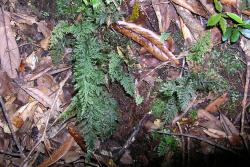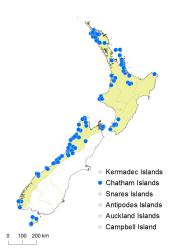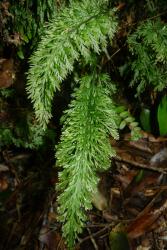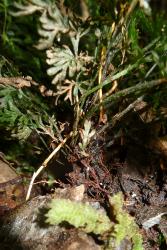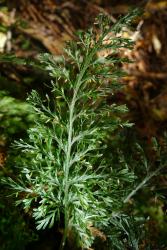- ≡ Trichomanes rigidum var. strictum (Menzies ex Hook. & Grev.) Field, Ferns New Zealand 72 (1890)
- ≡ Macroglena stricta (Menzies ex Hook. & Grev.) Copel., Philipp. J. Sci. 67: 85 (1938)
- ≡ Abrodictyum strictum (Menzies ex Hook. & Grev.) Ebihara & K.Iwats. in Ebihara et al., Blumea 51: 243 (2006)
- = Trichomanes leptophyllum A.Cunn., Companion Bot. Mag. 2: 368 (1837)
Terrestrial ferns. Rhizomes erect, bearing red-brown hairs 1–3 mm long. Fronds 65–350 mm long, held upright. Stipes 20–160 mm long, pale brown sometimes becoming green distally, often very narrowly winged for a short distance distally, glabrous or with scattered hairs. Laminae 2-pinnatifid distally to 3-pinnatifid or rarely 4-pinnatifid proximally, narrowly elliptic or elliptic or narrowly ovate or ovate, 40–260 mm long, 15–80 mm wide, green, membranous, glabrous or with scattered hairs. Rachises narrowly winged throughout, brown or green, glabrous or with scattered hairs. Primary pinnae in 15–25 pairs, overlapping, narrowly elliptic or narrowly ovate or ovate, winged throughout; distal primary pinnae adnate; proximal primary pinnae more or less stalked; the longest primary pinnae at or below the middle, 10–67 mm long, 4–20 mm wide. Secondary pinnae overlapping, elliptic or obovate, winged throughout, more or less adnate; the longest 4–14 mm long, 2–6 mm wide. Ultimate segments linear or oblong, entire, up to 4 mm long, 0.4–1.2 mm wide, adnate, each with a single unbranched vein; apices acute to obtuse; margins entire, with an indistinct border of shortened cells. Sori borne on short acroscopic and basiscopic segments near bases of secondary pinnae, several on each primary pinna, adnate; indusia tubular, 1–1.5 mm long, slightly widened at mouth; sporangia borne on a fine receptacle up to 19 mm long, projecting far beyond the indusia at maturity.
Trichomanes strictum is recognised by its erect rhizomes, fronds which are held upright, narrowly ovate laminae, winged rachises, linear ultimate segments with unbranched veins, and fine brown receptacles far-exserted beyond the indusial flaps.
North Island: Northland, Auckland, Volcanic Plateau, Gisborne, Taranaki, Southern North Island.
South Island: Western Nelson, Sounds Nelson, Westland, Fiordland.
Chatham Islands, Stewart Island.
Altitudinal range: 10–900 m.
In the North Island Trichomanes strictum occurs in montane areas from Northland through Coromandel to the Bay of Plenty and East Cape, and south to western Waikato. Elsewhere in the North Island it is confined to Mt Taranaki and the Tararua Ranges. It grows from about 300 m in the foothills of the Tararua Ranges to 870 m on Mt Taranaki and the Pukeamaru Range, East Cape, and to 900 m on Mt Te Aroha. In the South Island it occurs in the Marlborough Sounds, and from Whanganui Inlet to Fiordland and Stewart Island. It extends from near sea level on Stewart Island to 700 m on the Stockton Plateau.
Occurs on the ground, among roots, at the base of trunks, on rotting logs, on banks and damp rock faces, under overhangs, or on mossy streamsides in damp, shaded kauri, podocarp, beech and broadleaved forest.
In the classification of Ebihara et al. (2006), Trichomanes strictum is treated as Abrodictyum strictum.



